Asparagus and Goat Cheese Frittata
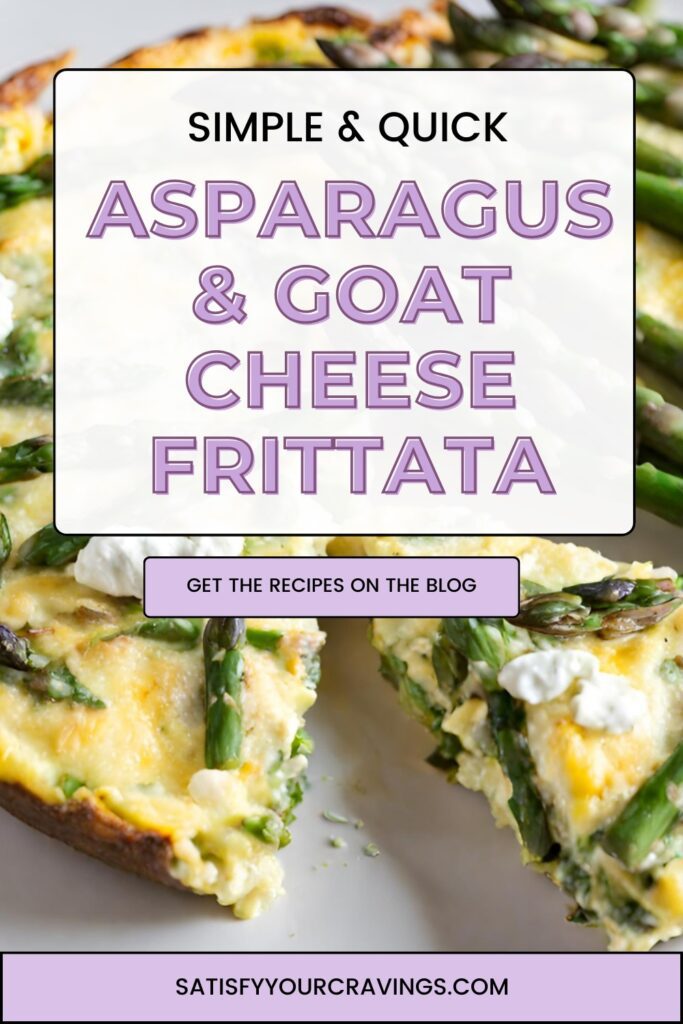
These partnerships help support our content and keep our recipes free for our amazing readers. We only recommend products and brands we personally use and trust in our own kitchen. Thank you for supporting us! 💛
A Healthy and Delicious Breakfast Recipe
Looking for a breakfast or brunch recipe that’s not only delicious but also healthy and easy to make? This asparagus and goat cheese frittata is just what you need! Bursting with fresh, vibrant asparagus and creamy goat cheese, this dish is a perfect balance of flavor and nutrition. Whether you’re hosting a weekend brunch or need a quick meal to power through your day, this recipe is a must-try. Plus, it’s naturally gluten-free and packed with protein, making it a great option for clean eating.
What makes this frittata even better is its versatility. You can serve it warm straight out of the oven or enjoy it chilled for meal prep. Pair it with a side salad for a light lunch or keep it simple with a cup of coffee for breakfast. It’s quick to prepare, easy to customize, and guaranteed to impress everyone at the table. Let’s dive into this easy-to-follow recipe that’s as beautiful as it is tasty!
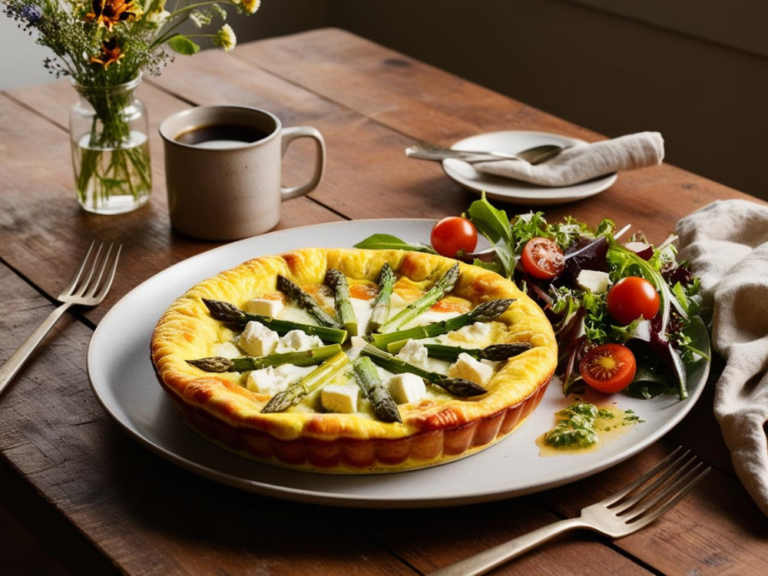
Why You’ll Love This Recipe
This asparagus and goat cheese frittata isn’t just another breakfast recipe—it’s a game-changer for your mornings! It’s packed with fresh, wholesome ingredients that not only taste amazing but also fuel your body with essential nutrients. The vibrant asparagus brings a fresh, earthy flavor and a pop of green, while the creamy goat cheese melts beautifully into the eggs, adding a tangy richness that makes every bite irresistible. Plus, the frittata’s golden, fluffy texture is simply perfection.
What makes this recipe even better is its versatility. Whether you’re looking for a quick and satisfying breakfast, a standout dish for brunch with friends, or an easy meal-prep option, this frittata checks all the boxes. It’s naturally gluten-free, high in protein, and perfect for clean eating. And the best part? You can easily customize it to fit your taste or dietary preferences. Add your favorite herbs, throw in extra veggies, or pair it with a fresh side salad to make it uniquely yours. Trust us—once you try it, you’ll wonder how you ever lived without it!
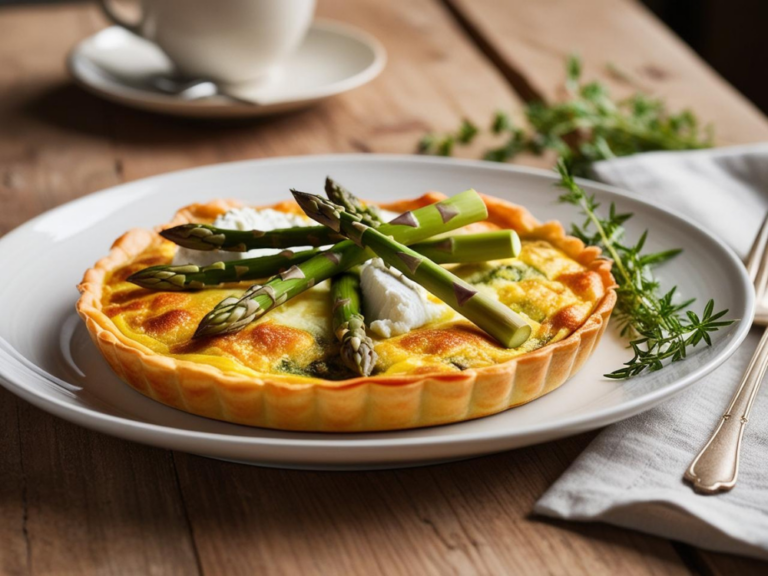
History and Fun Facts About Frittatas
Did you know that the humble frittata has a fascinating history rooted in Italian cuisine? The word “frittata” comes from the Italian verb friggere, which means “to fry.” Traditionally, a frittata was a simple dish made from eggs cooked in a skillet, often as a way to use up leftover ingredients. Over time, it evolved into the beloved, versatile meal we know today—a delicious canvas for endless combinations of meats, vegetables, cheeses, and herbs.
Frittatas are often called the Italian cousin of the French omelet, but they have some key differences. Unlike an omelet, which is folded and served immediately, a frittata is cooked slowly over low heat and finished in the oven to create a fluffy, golden masterpiece. This method gives the frittata its signature texture—crispy edges with a tender, custardy center.
Here’s a fun fact: in Italy, frittatas are often served at room temperature, making them a popular dish for picnics and gatherings. They’re also considered the ultimate “fridge-cleaning” meal, as you can toss in whatever ingredients you have on hand. Historically, this made them a practical choice for families who wanted to stretch their resources while still enjoying a hearty, satisfying meal.
Frittatas have also gained a global following because of their versatility and ease of preparation. They’re enjoyed in various forms around the world, often customized to reflect regional flavors. For example, in Spain, you’ll find the tortilla española, a frittata-like dish made with potatoes and onions. In the Middle East, egg-based dishes like kuku share similarities with the frittata, often featuring herbs and spices for a unique twist.
So, when you make this asparagus and goat cheese frittata, you’re not just whipping up a tasty meal—you’re participating in a culinary tradition that spans centuries and cultures. It’s a dish that’s stood the test of time, evolving to suit modern tastes while staying true to its roots as a simple, comforting meal. And now, you get to carry that tradition forward with your own delicious creation!
Try some of our other recipes!
Why This Asparagus and Goat Cheese Frittata is a Nutritional Powerhouse
One of the best things about this asparagus and goat cheese frittata is how it combines incredible flavors with a serious dose of nutrition. Let’s take a closer look at the ingredients and why they’re so good for you.
Asparagus: A Nutritional Powerhouse
Asparagus isn’t just a tasty addition to your meals—it’s a nutritional superstar! Packed with vitamins A, C, E, and K, as well as folate, it supports your immune system, promotes healthy skin, and even aids in bone health. It’s also high in antioxidants, which help combat inflammation and protect your body from oxidative stress. Plus, asparagus is a natural diuretic, which means it helps flush out toxins and reduce bloating. If that’s not enough, it’s also low in calories but high in fiber, making it perfect for maintaining a healthy weight while keeping you full and satisfied.
Goat Cheese: Creamy and Packed with Benefits
If you’re a cheese lover, goat cheese is a fantastic choice. It’s easier to digest than cow’s milk cheese because it contains less lactose and smaller fat molecules, which makes it a great option for people with mild dairy sensitivities. Goat cheese is also rich in calcium, magnesium, and protein, supporting strong bones and muscles. Its creamy texture and tangy flavor add a luxurious touch to this frittata without piling on unnecessary calories.
Eggs: The Protein Powerhouse
Eggs are often called nature’s multivitamin for a reason. They’re an excellent source of high-quality protein, which keeps you feeling full and helps build and repair muscle. Eggs also contain essential nutrients like vitamin D, choline, and selenium. Choline, in particular, is vital for brain health and development, making eggs a smart choice for boosting cognitive function. And don’t shy away from the yolks—they’re packed with healthy fats and essential nutrients that your body needs.
Olive Oil: Heart-Healthy Goodness
If you’re using olive oil to cook your frittata, you’re adding a dose of heart-healthy monounsaturated fats. Olive oil is known for its anti-inflammatory properties and its ability to lower bad cholesterol levels while increasing the good kind. It’s a staple in the Mediterranean diet and a perfect complement to the fresh flavors in this dish.
Herbs and Spices: Flavor and Health in Every Bite
Whether you’re sprinkling in some thyme, parsley, or black pepper, herbs and spices don’t just add flavor—they also come with their own health benefits. For example, parsley is loaded with vitamins and antioxidants, while black pepper can improve digestion and boost nutrient absorption. These small additions can make a big impact on both flavor and nutrition.
A Balanced, Nutrient-Dense Meal
When you put all these ingredients together, you’re left with a dish that’s as balanced as it is delicious. This frittata is high in protein, rich in vitamins and minerals, and low in carbs, making it a great option for anyone following a clean eating lifestyle. It’s also naturally gluten-free, which is a bonus for those with dietary restrictions.
This asparagus and goat cheese frittata isn’t just a meal—it’s a health-boosting powerhouse disguised as comfort food. Whether you’re making it for breakfast, brunch, or dinner, you can feel good knowing that every bite is packed with nutrients to fuel your body and mind. Healthy eating has never been this delicious!
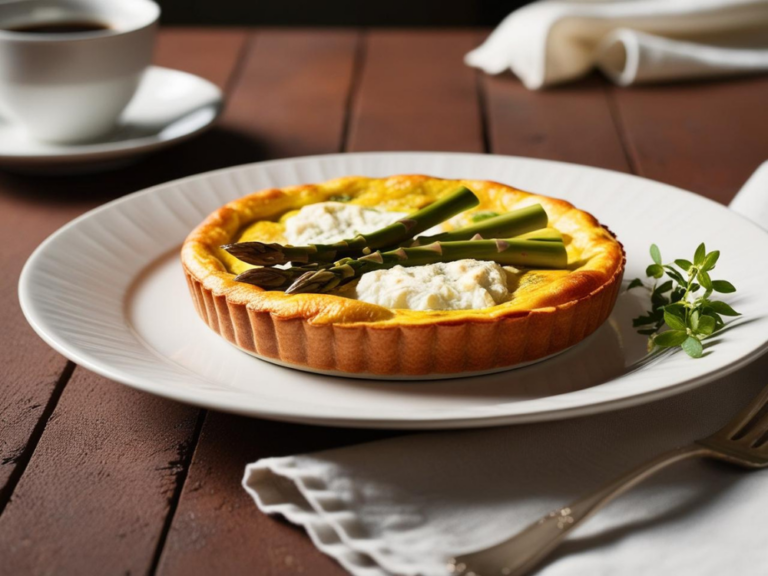
Frequently Asked Questions About Making the Perfect Frittata
When it comes to cooking a frittata, there are often a few questions that come up, especially if it’s your first time making one. Here’s a detailed guide to answer the most common questions so you can create a perfect asparagus and goat cheese frittata every time!
1. Can I Make This Frittata Ahead of Time?
Absolutely! Frittatas are an excellent make-ahead dish. You can prepare the frittata the night before, refrigerate it, and reheat it in the morning for a quick breakfast or brunch. It’s also perfect for meal prep—slice it into portions, store in airtight containers, and you’ll have a ready-to-go meal for busy weekdays.
2. How Do I Prevent My Frittata from Sticking to the Pan?
Using the right pan is key. Opt for a non-stick skillet or a well-seasoned cast iron pan to avoid sticking. Always coat the pan generously with olive oil or butter before adding the eggs. Preheating the pan can also help create a non-stick surface and ensure even cooking.
3. What If I Don’t Have an Oven-Safe Skillet?
No oven-safe skillet? No problem! You can start cooking the frittata on the stovetop in a regular skillet, then transfer the mixture to a greased baking dish to finish cooking in the oven. Just keep an eye on the cooking time, as the thickness of the frittata may affect how quickly it sets.
4. How Do I Keep My Frittata Fluffy?
The secret to a fluffy frittata lies in the eggs. Whisk them thoroughly to incorporate air, which helps create a light and airy texture. Avoid overloading your frittata with heavy ingredients, as too many toppings can weigh it down. Cooking it low and slow on the stovetop before transferring to the oven ensures even fluffiness throughout.
5. Can I Customize the Ingredients?
Of course! The beauty of a frittata is its versatility. While asparagus and goat cheese are the stars of this recipe, feel free to get creative. Add sautéed mushrooms, diced tomatoes, or spinach for extra veggies. Swap the goat cheese for feta, cheddar, or a dairy-free alternative if needed. The possibilities are endless!
6. What’s the Best Way to Reheat Leftovers?
Reheat frittata slices in the oven at 350°F (175°C) for about 10–15 minutes, or use a skillet on the stovetop for a quick warm-up. Avoid microwaving for too long, as it can make the eggs rubbery. If you’re in a hurry, 30 seconds in the microwave should do the trick.
7. Why Is My Frittata Soggy in the Middle?
A soggy center usually means the frittata wasn’t cooked all the way through. Make sure to cook it on low heat on the stovetop until the edges are set, then transfer it to the oven to finish baking. You can also gently shake the pan or use a toothpick to test if the center is fully set before removing it from the oven.
8. Can I Freeze Frittata?
Yes! Frittata freezes beautifully. Once it’s completely cooled, slice it into individual portions, wrap them tightly in plastic wrap or foil, and store them in a freezer-safe container. When you’re ready to eat, thaw overnight in the fridge and reheat in the oven or on the stovetop.
9. What Side Dishes Pair Well with This Frittata?
This asparagus and goat cheese frittata pairs wonderfully with a fresh side salad, roasted potatoes, or crusty bread. For a lighter option, serve it with seasonal fruit or a simple avocado toast.
10. Is a Frittata Healthy?
Absolutely! With protein-packed eggs, nutrient-rich asparagus, and creamy goat cheese, this frittata is as nutritious as it is delicious. It’s low in carbs, naturally gluten-free, and perfect for a clean eating lifestyle. Plus, you can adjust the ingredients to suit your dietary preferences.
These FAQs should help you troubleshoot any issues and feel confident in making this recipe. Once you master the basics, you’ll find that frittatas are one of the easiest, most adaptable dishes you can make. Have another question? Drop it in the comments, and I’ll be happy to help!
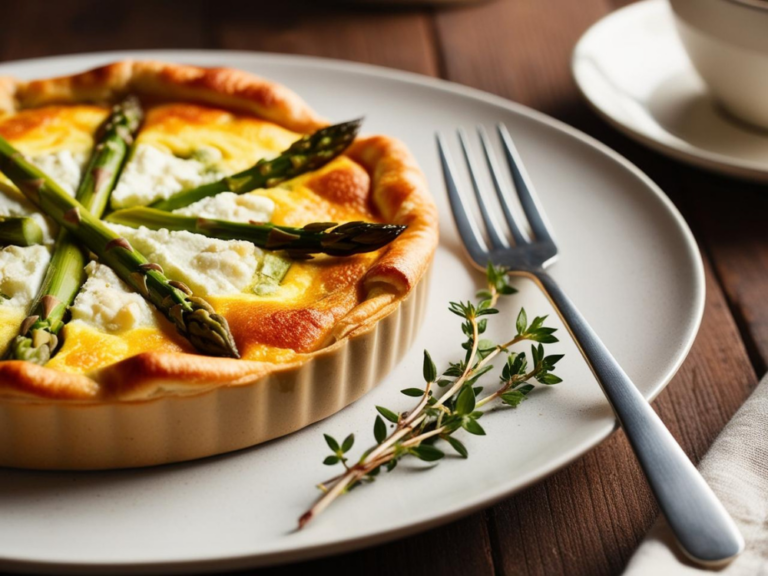
How to Make This Frittata Kid-Friendly
Frittatas are a fantastic way to sneak healthy ingredients into your family’s diet, but sometimes picky eaters—especially kids—might need a little extra convincing. Don’t worry! With a few tweaks, you can make this asparagus and goat cheese frittata a kid-approved hit while still keeping it nutritious and flavorful.
1. Start with Familiar Ingredients
Kids are more likely to try a dish if it includes ingredients they already enjoy. While asparagus and goat cheese are delicious, they might not be the easiest sell to a younger palate. Try chopping the asparagus into smaller, bite-sized pieces so it blends into the frittata seamlessly. If goat cheese is too tangy, swap it out for a milder cheese like mozzarella, cheddar, or cream cheese.
2. Make It Colorful and Fun
Presentation is key when it comes to appealing to kids. Use colorful veggies like red bell peppers, cherry tomatoes, or sweet corn to make the frittata more visually exciting. You can even arrange the toppings into fun patterns, like a smiley face or a star, before baking. The more fun it looks, the more likely they are to dig in!
3. Involve Them in the Cooking Process
Kids love to help out in the kitchen, and getting them involved in preparing the frittata can make them more excited to eat it. Let them whisk the eggs, sprinkle the cheese, or help arrange the toppings. It’s a great way to teach them about healthy eating while creating a sense of ownership over the meal.
4. Add Familiar Flavors
If your child has a favorite flavor, incorporate it into the frittata. For example, if they love pizza, add a sprinkle of oregano and some shredded mozzarella for a pizza-inspired frittata. If they’re fans of breakfast sausage, crumble in some cooked sausage to give it a hearty twist.
5. Serve with a Kid-Friendly Side
Pair the frittata with sides that kids love, like toast cut into fun shapes, fresh fruit, or a small serving of ketchup or ranch dressing for dipping. Familiar sides can make the frittata feel less intimidating and more approachable.
6. Create Mini Frittatas
If the idea of a big slice of frittata seems overwhelming, try making mini versions in a muffin tin. These bite-sized portions are easy for little hands to grab and make eating more fun. Plus, you can customize each mini frittata with different toppings to suit everyone’s tastes.
7. Use Mild Seasonings
While adults might enjoy the punch of garlic, herbs, and black pepper, kids often prefer milder flavors. Keep the seasoning simple—just a pinch of salt and a little cheese go a long way. You can always add more seasoning to individual portions for the grown-ups.
8. Make It a Breakfast Sandwich
Turn the frittata into a fun breakfast sandwich! Cut it into squares and layer it between slices of toast, bagels, or English muffins. Add a slice of cheese or a drizzle of ketchup for an easy, handheld meal kids will love.
9. Highlight the “Egg Pie” Connection
If your kids like pie, explain that a frittata is kind of like a savory “egg pie.” The familiar concept might make them more willing to give it a try. You could even let them call it a special name, like “super egg pie” or “breakfast pizza.”
10. Sneak in More Veggies
If your kids aren’t huge fans of veggies, finely chop or grate them so they blend into the frittata. Zucchini, carrots, or even spinach can disappear into the mix while still adding plenty of nutrients.
By using these tips, you can transform this asparagus and goat cheese frittata into a dish that’s both nutritious and kid-approved. It’s a great way to introduce your little ones to new flavors and textures while ensuring they’re getting a balanced meal. Plus, you’ll love how easy it is to customize for the whole family!

Ingredients Breakdown: What Makes This Frittata Shine
A great recipe starts with great ingredients, and this asparagus and goat cheese frittata is no exception. Each ingredient brings its own unique flavor, texture, and nutritional benefits to the table. Let’s take a closer look at what makes these components so essential and how you can make the most of them.
1. Fresh Asparagus
Asparagus is the star of this dish, and for good reason. Its vibrant green color, tender-crisp texture, and slightly earthy flavor pair perfectly with the creamy goat cheese and fluffy eggs. Look for bright green spears with tightly closed tips when shopping for asparagus. If the ends feel woody, simply trim or peel them before cooking. Not only does asparagus add flavor, but it’s also packed with vitamins A, C, and K, making this frittata a nutritious choice.
Pro Tip: If asparagus is out of season, substitute it with another green vegetable like broccoli, spinach, or zucchini for a similar fresh flavor.
2. Creamy Goat Cheese
Goat cheese takes this frittata to the next level with its rich, tangy flavor and creamy texture. It melts beautifully into the eggs, creating pockets of flavor in every bite. Compared to other cheeses, goat cheese is lower in fat and easier to digest, making it a great choice for those with lactose sensitivity. You can use a soft, spreadable goat cheese or opt for crumbled goat cheese for more texture.
Pro Tip: If goat cheese isn’t your thing, try swapping it with feta, mozzarella, or even a plant-based cheese for a dairy-free version.
3. Farm-Fresh Eggs
Eggs are the foundation of any frittata, and their quality makes a big difference. Fresh, free-range eggs tend to have brighter yolks and richer flavor, which translates to a more vibrant and delicious dish. Eggs are a powerhouse of protein and essential nutrients like choline, which supports brain health. Whisking them thoroughly before cooking ensures a light and fluffy frittata.
Pro Tip: Add a splash of milk or cream to the eggs for an even creamier texture.
4. Olive Oil or Butter
The cooking fat you use plays a subtle but important role in the flavor and texture of your frittata. Olive oil adds a hint of fruitiness and is packed with heart-healthy monounsaturated fats. If you prefer a richer flavor, butter is an excellent alternative. Either option helps create a non-stick surface for cooking and enhances the golden-brown crust of the frittata.
Pro Tip: Use a high-quality olive oil or unsalted butter for the best flavor.
5. Aromatics: Garlic and Onion (Optional)
Adding minced garlic or diced onion can elevate the flavor profile of your frittata, giving it a savory depth that complements the asparagus and goat cheese. Sauté them lightly in the pan before adding the eggs to release their natural sweetness.
Pro Tip: If you’re short on time or prefer a milder flavor, green onions or chives are quick, easy, and equally delicious options.
6. Herbs and Seasonings
Fresh or dried herbs like thyme, parsley, or dill add a layer of freshness to the frittata. Seasoning the eggs with salt and a touch of black pepper enhances the natural flavors of the ingredients. For an extra kick, a pinch of red pepper flakes or smoked paprika can work wonders.
Pro Tip: Save some fresh herbs to sprinkle on top after baking for a burst of flavor and a beautiful garnish.
7. Milk or Cream (Optional)
While not essential, a splash of milk or cream can make the frittata richer and more velvety. This addition is especially helpful if you’re aiming for a custard-like texture. Opt for whole milk, half-and-half, or even a non-dairy alternative like almond or oat milk if you’re looking to keep it lighter.
Pro Tip: Avoid adding too much liquid, as it can make the frittata too dense or watery.
8. Cheese for Topping (Optional)
While the goat cheese inside the frittata provides plenty of flavor, adding a sprinkle of shredded Parmesan or cheddar on top before baking can create a delicious, golden crust.
Pro Tip: Place the frittata under the broiler for the last minute or two of cooking to get a perfectly bubbly and browned topping.
By understanding the role of each ingredient, you can appreciate how they work together to create a balanced and flavorful dish. Whether you stick to the classic asparagus and goat cheese combo or decide to mix things up, this recipe is a testament to how simple, fresh ingredients can transform into something truly special. Now, let’s get cooking!
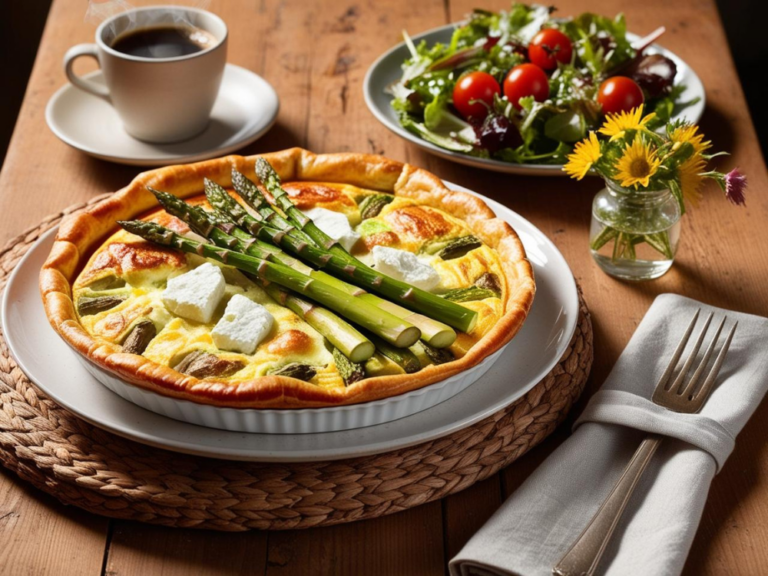
These partnerships help support our content and keep our recipes free for our amazing readers. We only recommend products and brands we personally use and trust in our own kitchen. Thank you for supporting us! 💛
🛍️ Shop the Recipe
Make your morning (or anytime!) feel like a cozy weekend brunch with this simple yet elevated asparagus and goat cheese frittata 🌿🧀✨ Whether you’re serving it fresh out of the oven or slicing it up for meal prep, these tools and ingredients will help you create the perfect light and creamy dish with ease.
As an Amazon Associate, I earn from qualifying purchases. Thank you for supporting Satisfy Your Cravings — it allows us to keep sharing healthy recipes you love! 💛
✅ 10-Inch Oven-Safe Skillet – Perfect for Frittatas & One-Pan Meals
✅ Whisk Set – For Light & Fluffy Eggs
✅ Organic Goat Cheese – Creamy, Tangy & Clean
✅ Asparagus Steamer Basket – For Quick, Even Cooking
✅ Free-Range Organic Eggs – For Rich Flavor & Nutrition
✅ Herb Scissors – Easily Snip Fresh Parsley, Dill & More 🌿
✅ Glass Meal Prep Containers – Store Leftovers the Healthy Way
💡 Clean Brunch Tip: Use pasture-raised eggs for more nutrients and vibrant yellow yolks. And don’t overcook your asparagus — a quick steam or sauté keeps it crisp and fresh!
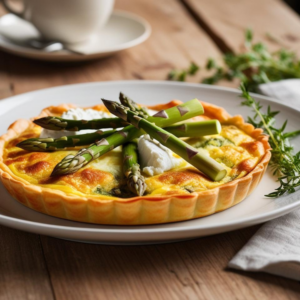
Asparagus and Goat Cheese Frittata.
Equipment
- Skillet: A 10–12 inch oven-safe skillet (cast iron or non-stick) for cooking on the stovetop and finishing in the oven.
- Mixing Bowl: Medium-sized, for whisking eggs and combining the mixture.
- Whisk or Fork: To beat the eggs until they’re light and fluffy.
- Cutting Board and Knife: For trimming and chopping asparagus and other vegetables.
- Measuring Spoons and Cups: For accurately measuring olive oil, cheese, and other ingredients.
- Spatula: Heat-resistant, for sautéing vegetables and spreading the egg mixture evenly.
- Oven Mitts or Pot Holders: For safely transferring the skillet from stovetop to oven.
- Box Grater (Optional): For grating cheese if adding a topping.
- Muffin Tin (Optional): For making individual, mini frittatas.
- Serving Plate or Platter (Optional): For presenting the frittata after slicing.
Ingredients
- 8 Large eggs
- 1/4 Cup Milk or cream
- Salt and pepper to taste
- 1 Tbsp Olive oil
- 1 Bunch Asparagus, trimmed and cut into 1-inch pieces
- 1 Small onion, finely chopped
- 4 ounce Goat cheese, crumbled
- 2 Tbsp Chopped fresh parsley
- Optional: grated Parmesan cheese for topping
Instructions
- You'll preheat the oven to the broil setting for this recipe. Typically, broiling is done at high heat, which is around 500°F (260°C). However, ovens can vary, so it's essential to keep an eye on the frittata while broiling to prevent burning.
- In a bowl, whisk together the eggs, milk or cream, salt, and pepper until well combined. Set aside.
- Heat olive oil in an oven-safe skillet over medium heat. Add the chopped onion and sauté until translucent, about 3-4 minutes.
- Add the asparagus pieces to the skillet and cook until tender-crisp, about 5-6 minutes.
- Pour the egg mixture evenly over the asparagus and onion in the skillet. Sprinkle crumbled goat cheese and chopped parsley on top.
- Cook the frittata on the stovetop for 3-4 minutes, or until the edges start to set.
- Transfer the skillet to the preheated oven and broil for 3-5 minutes, or until the top is set and lightly golden brown.
- Remove from the oven and let the frittata cool slightly before slicing and serving. Optionally, sprinkle grated Parmesan cheese on top before serving.
Notes
Heating and Storage Directions for Asparagus and Goat Cheese Frittata
Storage Instructions
-
Refrigerator:
- Allow the frittata to cool completely before storing.
- Place slices in an airtight container or wrap the whole frittata tightly with plastic wrap or aluminum foil.
- Store in the refrigerator for up to 3–4 days.
-
Freezer:
- Slice the frittata into individual portions for easier thawing.
- Wrap each slice tightly in plastic wrap, then place them in a freezer-safe container or resealable bag.
- Label with the date and freeze for up to 2 months.
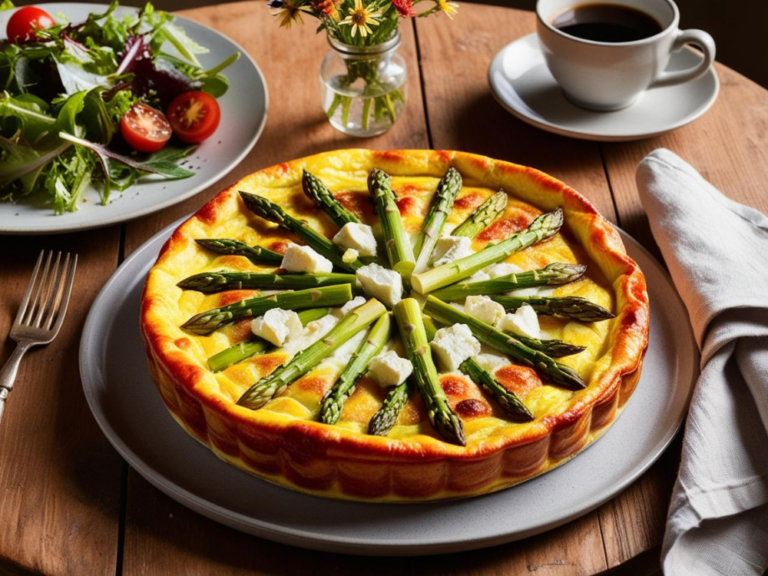
A Wholesome Dish for Every Occasion
There’s something so satisfying about a recipe that’s simple to make, packed with flavor, and versatile enough to fit any occasion. This asparagus and goat cheese frittata embodies all of that and more. Whether you’re serving it for a leisurely weekend brunch, preparing a healthy breakfast for busy mornings, or creating a light yet satisfying dinner, this dish is sure to impress.
With its vibrant asparagus, creamy goat cheese, and perfectly cooked eggs, this frittata isn’t just a meal—it’s a celebration of fresh, wholesome ingredients coming together beautifully. Best of all, it’s easy to customize, making it a recipe you can turn to time and time again for delicious, stress-free cooking.
Now it’s your turn! Try this recipe, make it your own, and enjoy every bite. Don’t forget to share your experience in the comments or tag us on social media—we’d love to see your creations. Here’s to making meals that bring joy, nourishment, and a little bit of magic to your table!
Join Now!
Love this recipe? Don’t miss out on even more delicious, healthy, and easy-to-make recipes like this Asparagus and Goat Cheese Frittata! By joining our email community, you’ll gain access to exclusive content, bonus recipes, and tips to make clean eating a breeze.
Enter your email & click below to subscribe and start receiving tasty inspiration right away. It only takes a minute to join our growing community of food lovers dedicated to making healthy eating delicious and fun.
These partnerships help support our content and keep our recipes free for our amazing readers. We only recommend products and brands we personally use and trust in our own kitchen. Thank you for supporting us! 💛
